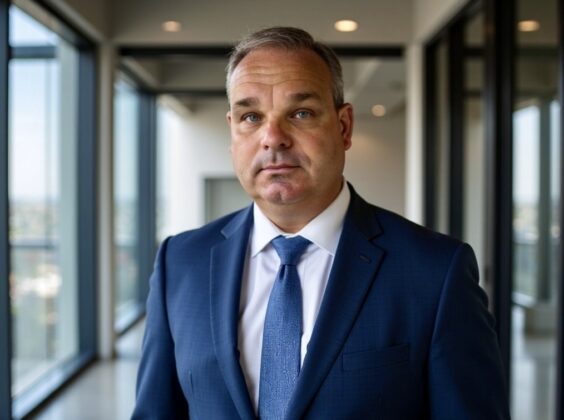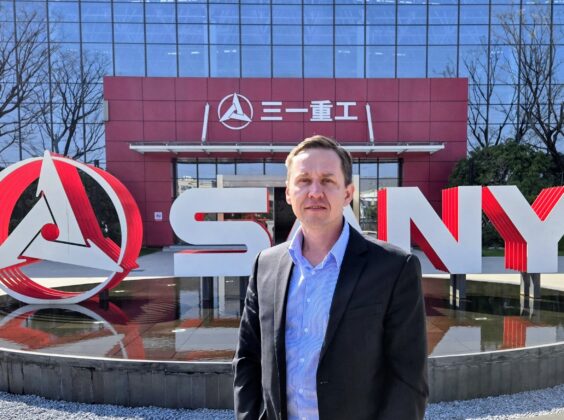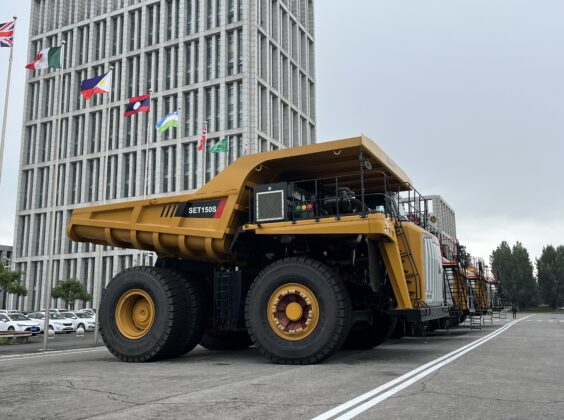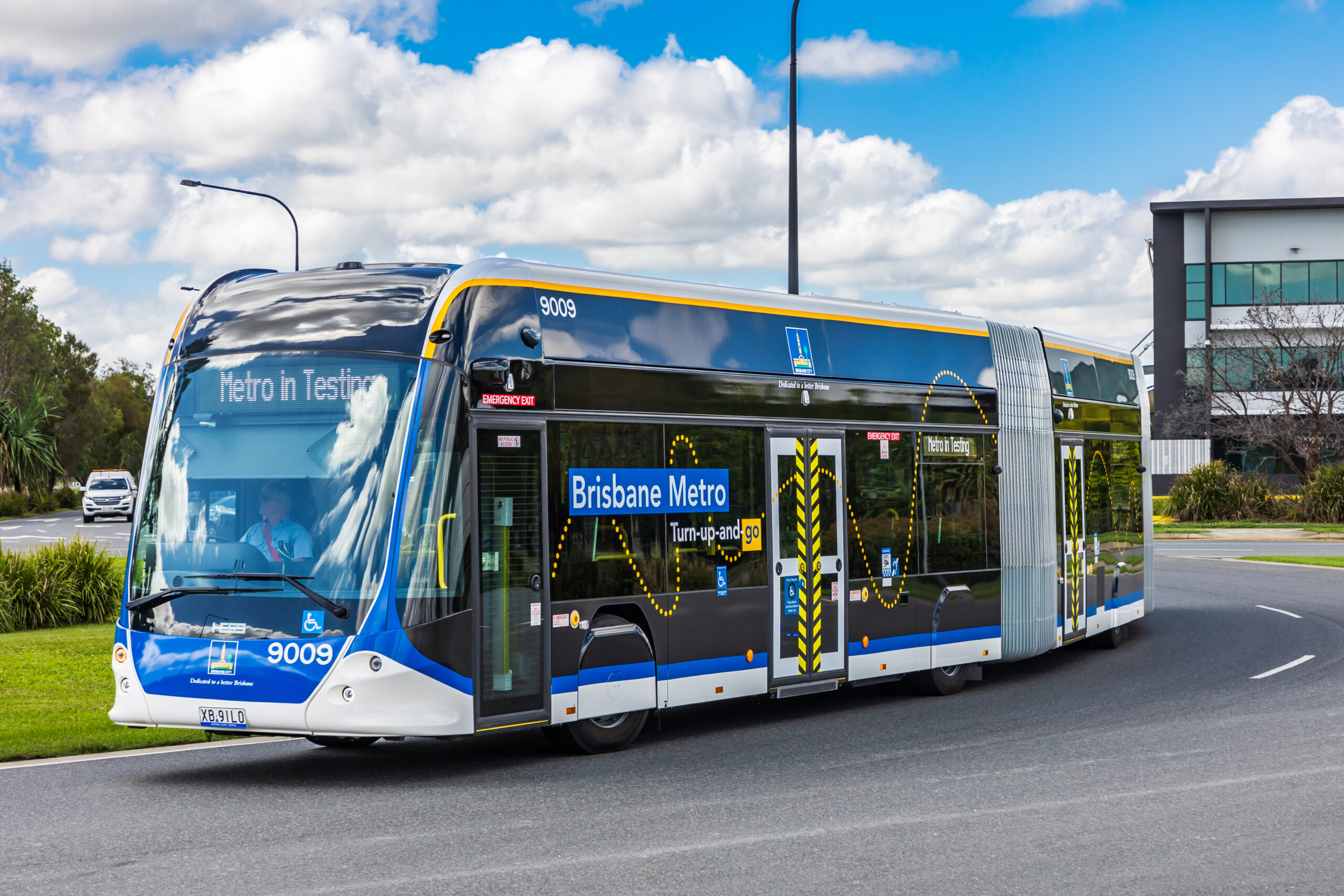In the past few years there has been a much greater engagement with the major Chinese mining equipment OEMs by the Western mining industry, for various reasons. These include their available range of machines already proven, large production capacity, plus flexibility and willingness to customise and meet specific needs – especially in relation to green powertrains and OEM-agnostic autonomy, but also the innovation itself and the proven performance of new technologies within China itself as well as in emerging markets.
SANY is one of these companies – and it is preparing to enter the Australian market with its hybrid mining trucks, already well established in other major mining markets from Uzbekistan to Peru. Ahead of its presence at the forthcoming IMARC event in Sydney, IM Editorial Director Paul Moore caught up with Dominic te Wierik, Regional Sales and Marketing Director – Mining & Denis Orlov, General Manager – Key Mining Accounts, Australia; both at SANY Group.
Left: Denis Orlov, General Manager – Key Mining Accounts, Australia; Right: Dominic te Wierik, Regional Sales and Marketing Director – Mining – SANY Group


Q Can you summarise your roles and where SANY is today with its Australian presence and growth plans?
Both of us have been with SANY now for six months or just over and our initial role has been to introduce those trucks, the SET150S which is a twin engine, diesel-electric (battery) hybrid rigid haul truck model with 136 t payload. We have some committed customers that we’re working through final arrangements with at the moment, which will mean we’ll have trucks in the dirt conservatively from January 2026. We have two separate customers, which we cannot name for confidentiality reasons – but the trucks will be running in the Pilbara iron ore mining hub in WA. We can also say that these are owner operator miners not contractors, though we are also in advanced discussions with both contract miners and mining services companies. We have taken these customers to the factory in Shenyang so they can see the scale, capability and quality of manufacturing, and the R&D focus, as well as in the mines themselves the already proven performance of these trucks.
Q What special allowances have you had to make for the Australian market? Why start with the SET150S from the SANY range?
The Australian market has very exacting standards so we have also been progressing some modifications to ensure we comply with all the safety regulations. We recently finished a full compliance study for all the Australian standards and so that’s all passed and tested. All the units that are coming in will have the right sized handrails, 45° ladders, the correct isolators, battery starter modes, accumulators, cumulative pressurisation decals, locks, padlocks, everything. The beauty of the SET150S is that it is still a very conventional truck in terms of its outline, weight distribution, tyres, dump body etc. But now you have two smaller 16 litre engines – which contributes to it having a much shorter lead time compared to the competition, plus it brings a huge improvement on the capital cost and on productivity; and minimal disruption to the way the mine sites are doing business. Not only that, but the truck is designed with a view of going full electric in the future when the technology justifies it, by reducing the amount of engines/engine power or getting rid of the engines all together. Beyond the SET150S, SANY also has the SET240S in its lineup – a 220 t, three engine diesel-electric (battery) hybrid. Once we finish certification, we intend to bring that model to Australia in 2026 as well. Both are made at SANY’s mining equipment factory in Shenyang. And beyond that we also have the 290 t class SET320S as well.
Q Where does the demand lie in terms of customer type? What type of sales options will you provide?
The market varies in Australia – some of the larger miners are looking at full battery electric from the start as they are making the investments in their onsite electrical infrastructure anyway to support them. But most of the medium sized miners, plus some of the big ones along with pretty much all of the contractors, are more interested in a hybrid model because it gives flexibility plus doesn’t require them to make huge infrastructure investments at this stage. It’s a similar story to what is happening with underground loaders, where hybrid or at least electric drive models are dominating over battery machines in Australia today when you talk about lower emissions options. For our customers, having a hybrid is a great step forward in reducing diesel costs and total cost of ownership, in addition to the emissions wins. We offer both a full out outright purchase agreement as well as a trial to buy kind of approach. We have put in place these options to offer flexibility – plus we have also done a lot of preparation in terms of the components and supplies network and warehousing. We also give customers options – some would like to start now with a smaller hybrid truck with a future view of when they are due for replacement, they can go full electric when the infrastructure side is ready and also have the option of going autonomous as well. We can provide that staged approach in terms of the power and then operation of the truck.
The SET150S gives miners a chance to take a staged approach in their electrification strategy

Q Has the attitude towards Chinese OEMs changed in Australia for mining machinery specifically?
There has been a big change in the attitude to Chinese OEMs – partly helped by the full integration of construction class machines from China into Australia and other Western markets – everything from wheel loaders to crawler cranes. In larger class mining machinery, in the past there was a tendency to see Chinese machines as copying or mimicking Western designs, with variable consistency in performance and quality. Today, the Chinese OEMs are actually leading the innovation, with trucks like these hybrids, but also wide body trucks. And they have made huge investments in their factories and supply chains. In 2024, SANY invested 5.9% of its revenue into R&D, which compared to the industry average is high. It also has a very wide product range compared to the existing established OEMs and mining. And that’s not just in mining trucks, it includes SANY’s New Energy division with microgrids as well as wind and solar products. So it can offer a complete new energy solution. SANY is taking a very strategic, staged approach to the market. The SET150S being a hybrid, and being twin engine, brings many benefits. We designed a brand new truck from the ground up with the view that you cannot just build another truck, a cheaper version of those from the established OEMs, and hope for success. With these SET trucks, SANY realised it could bring immediate decarbonisation benefits to mining customers without requiring a huge amount of infrastructure investment and change management at the mine site.
Q What engines will these SET150S trucks use and why?
All of the trucks going to the Australian market will have the 16 litre Volvo Penta TAD1643VE-B. In other parts of the world including China, Russia and Uzbekistan, the SET range trucks have other options like Chinese Weichai engines, which are well supported in those locations, but for the Australian market, Volvo Penta was the right choice – there is a very good service and support network in Australia plus it is already a well known industrial engine that is proven in underground mining machinery, most notably Sandvik underground trucks and loaders. It is also readily available off the shelf and very affordable from an engine change out perspective. We are working closely with their WA dealer, Ches Power Group (CPG).
Q What about the supply of other major components? How will you provide essential support?
Whilst we have our own dump body, we have set up a good relationship with several of the major dump body suppliers in Australia to ensure we have the right tray for the trucks as well based on field experience we have had with the SET trucks elsewhere. For the main drivetrain of the truck including traction alternators and wheel motors, SANY is working with CRRC which is the high-quality market leader in that technology with a huge population in the high speed rail market. Plus, they are not new to the market in Australia as they also support a lot of other OEM electric drive trucks in the country already. Overall, we have committed to holding all the required critical components and parts at our facility in WA to make sure that trials and the first rollouts plus any future rollouts are successful because we know what it takes to be in this market. We are also engaging with potential service partners on a project basis to support the fleets going in and hopefully that could grow further from there. For this new equipment, we will have the componentry support and the service support to make it work.
Q Can you go through the advantages of having two or three smaller engines from a performance, cost and maintenance point of view?
From the design point of view for SET150 truck engines, they are mounted radiator plus engine plus traction alternator on a subframe as a unit. And they are interchangeable left to right. And this unit is also interchangeable on the larger SET240 model, which has three of them. So, you already have immediate advantages there in terms of the components change out. We can have a complete replacement unit ready rather than an individual component when it comes to major maintenance cycles. So we can slide the new unit in, and slide the old one out, plus we have the potential to overhaul the used unit and update the components then have it ready for the next maintenance that is scheduled. The fact that two smaller engines have a lower oil volume and lower coolant volume results in huge savings in terms of those fluid costs but also cost associated with the disposal of those fluids through the life of the truck.
Q What are the hybrid upsides in the pit with the SET150S?
There are operational benefits from it being a true hybrid in terms of productivity, as the hybrid electric battery gives a good kick in terms of acceleration plus we have higher speeds on grades. Thanks to the SANY intelligent energy management system, the truck optimises engine and battery operation, and enables regenerative braking. It improves engine performance curves and the engines themselves because of the battery power support operate in the lowest brake specific fuel consumption RPM range from 1,400 to 1,600 RPM for the majority of the life. So you don’t have to get to the full power and see 1,800-1,900 RPM on grade all the time. So the engines have a much easier life which results in lower emissions, lower cost, longer component life and the hybrid design provides all these by default. Another plus is that if you do have an engine failure, the power of the other engine is still enough to get you back to the workshop without the truck having to be towed out of the pit. You might have to dump the truck load, but you can get the truck to safe area or the workshop with one engine down. The engine management system is all controlled through CRRC smarts and is a highly proven product.
Q The SANY mining range is very large – what about other models and equipment types?
Of course wide body trucks are of interest in Australia as well –such as the 70 t class SKT105S diesel truck but also the full battery electric SKT105E as well as the smaller 60 t class SKT90S and SKT90E. Then in the SET models we have the smaller SET100S with 91 t payload. In addition, starting from this year, we already have the SANY SY1250H 120 t excavator available, but soon we will also have the larger SY2000H (200 t), SY3000H (300 t) and SY4000H (400 t) models as well. So we will have a suite of loading units for the typical mining trucks in use in Australia. Plus all these excavators will be available either as diesel or electric. Wide body trucks provide many advantages to the customers in terms of narrowing haul road profiles, so your strip ratio is improved. You also don’t have the TKPH issues that are common for the larger trucks. And you can get away with smaller workshops, smaller cranes, so all those benefits plus these trucks provide a very cost efficient option from the capital perspective for contractors for example. And if they are autonomous, then they’ll also provide a huge operational improvement. In China, we have more than 200 wide body trucks operating across eight different sites autonomously. Plus we are already engaging with Tier 1 miners in Australia and other mining companies on core issues of concern with them that we can help with such as the fact we can offer full interoperability of our autonomous trucks with different fleet management systems.




